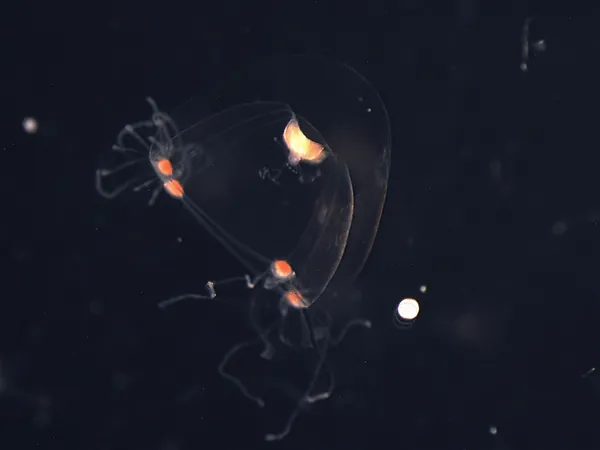
Unlocking the Secrets of Vision: How a 28-Eyed Jellyfish is Revolutionizing Our Understanding of Sight
2025-06-09
Author: Nur
In an exciting breakthrough, researchers from the Macias-Muñoz lab have sequenced the genome of an extraordinary jellyfish species, shedding light on the enigmatic origins of vision.
The Evolutionary Puzzle of Sight
One of the greatest mysteries in evolutionary biology is the development of complex vision across species. Jellyfish, fascinatingly, have evolved various types of eyes independently at least nine times. With their range of eyesight—from rudimentary eyespots that only sense light intensity to intricate lens eyes akin to those found in humans—they are key to unraveling this conundrum.
A Treasure Trove of Genetic Information
Biologists have long studied jellyfish to uncover details about their eye structure and visual capabilities. Yet, the specific genes responsible for the formation of jellyfish eyes have remained elusive. Aide Macias-Muñoz, an expert in ecology and evolutionary biology, is pioneering this research using cutting-edge genetic tools. The lab's latest triumph is the successful sequencing of the genome from Bougainvillia cf. muscus, a small jellyfish boasting an astonishing 28 eyes.
Initially aiming to study the more common Tripedalia cystophora (box jellyfish), the researchers were thrilled to discover Bougainvillia in their seawater tank. Known for being challenging to maintain in a lab setting, this jellyfish revealed itself as a scientific gem. The team managed to extract DNA from just 15 tiny specimens, paving the way for a comprehensive genetic map featuring over 46,000 predicted genes—believed to be the first genome for a jellyfish with this many eyes.
Unraveling the Genetic Toolkit of Vision
Macias-Muñoz stated, 'This new genome is a remarkable resource for comparative studies aimed at understanding how animal vision evolved and what genetic toolkit was available to their last common ancestor.' The jellyfish's eyes, known as ocelli, are simple light detectors lacking the sophistication of lens eyes.
The genome analysis revealed 20 unique 'opsins'—light-sensitive proteins vital for vision in many animals, while humans have only four. Intriguingly, the opsins in Bougainvillia differ from those in more familiar jellyfish species, indicating a distinct evolutionary pathway to vision. The researchers also uncovered additional genes linked to eye development and light sensitivity.
Paving the Way for Future Research
This groundbreaking genome offers invaluable insights into how vision evolves, particularly how simple eyes emerge across various evolutionary branches. The Macias-Muñoz lab is committed to further exploring the genetics of eye evolution, aiming to identify which vision-related genes from Bougainvillia play a role in light detection.
Moreover, they are delving into the genetics of eye regeneration. Cnidarians like Bougainvillia can remarkably regrow their eye-containing sensory structures—similar to lizards regrowing their tails—a rare capability that might unlock new understanding into the formation and healing of visual systems.
Getting Closer to the Evolutionary Truth
Reflecting on the complexity of vision, Charles Darwin once expressed discomfort at its evolution, yet acknowledged the gradual developments that led to it. The nuanced variations found in jellyfish may very well hold the key to this enduring mystery. With more genomes from uniquely eyed species like the 28-eyed Bougainvillia, we inch closer to revealing the secrets of evolutionary sight.


 Brasil (PT)
Brasil (PT)
 Canada (EN)
Canada (EN)
 Chile (ES)
Chile (ES)
 Česko (CS)
Česko (CS)
 대한민국 (KO)
대한민국 (KO)
 España (ES)
España (ES)
 France (FR)
France (FR)
 Hong Kong (EN)
Hong Kong (EN)
 Italia (IT)
Italia (IT)
 日本 (JA)
日本 (JA)
 Magyarország (HU)
Magyarország (HU)
 Norge (NO)
Norge (NO)
 Polska (PL)
Polska (PL)
 Schweiz (DE)
Schweiz (DE)
 Singapore (EN)
Singapore (EN)
 Sverige (SV)
Sverige (SV)
 Suomi (FI)
Suomi (FI)
 Türkiye (TR)
Türkiye (TR)
 الإمارات العربية المتحدة (AR)
الإمارات العربية المتحدة (AR)